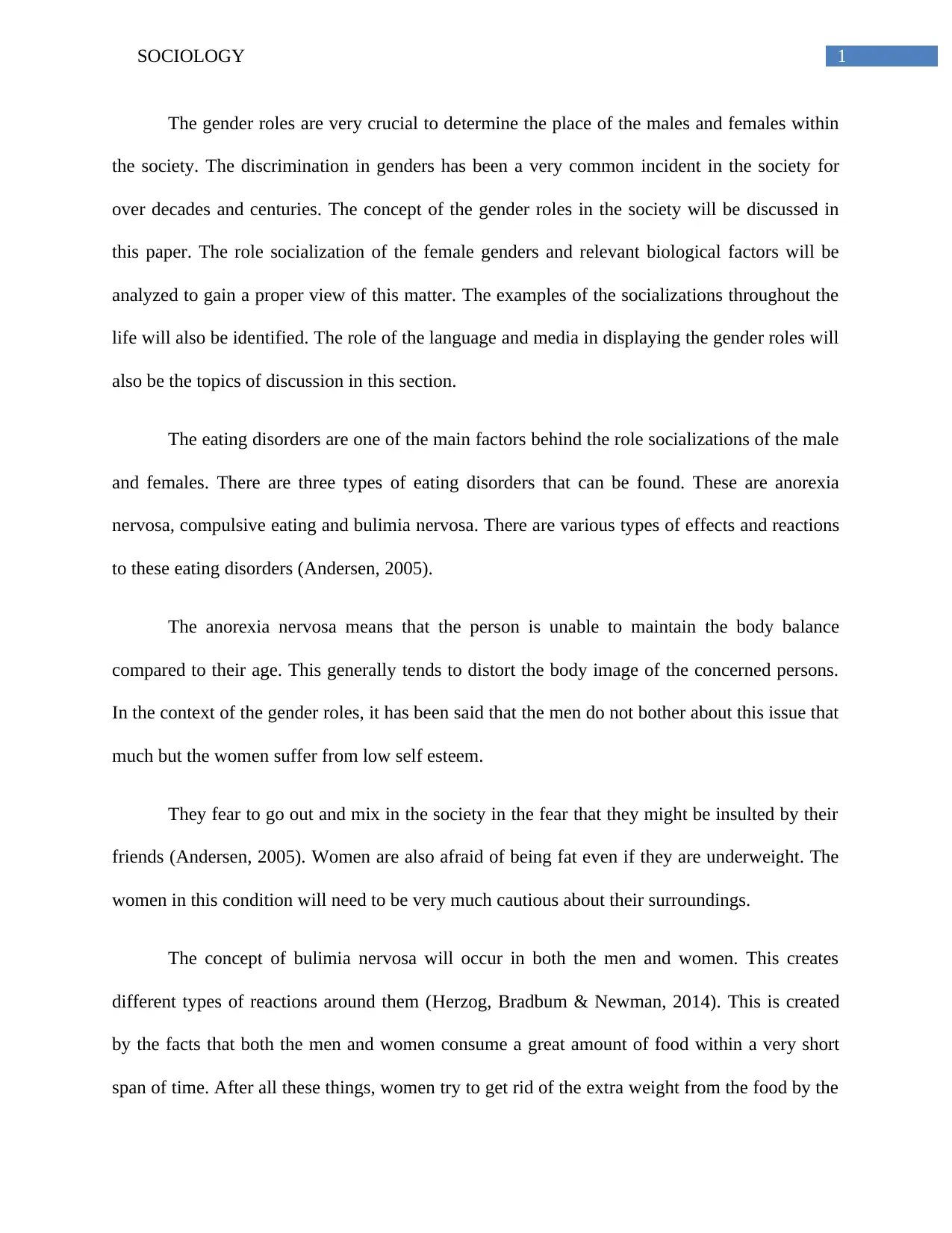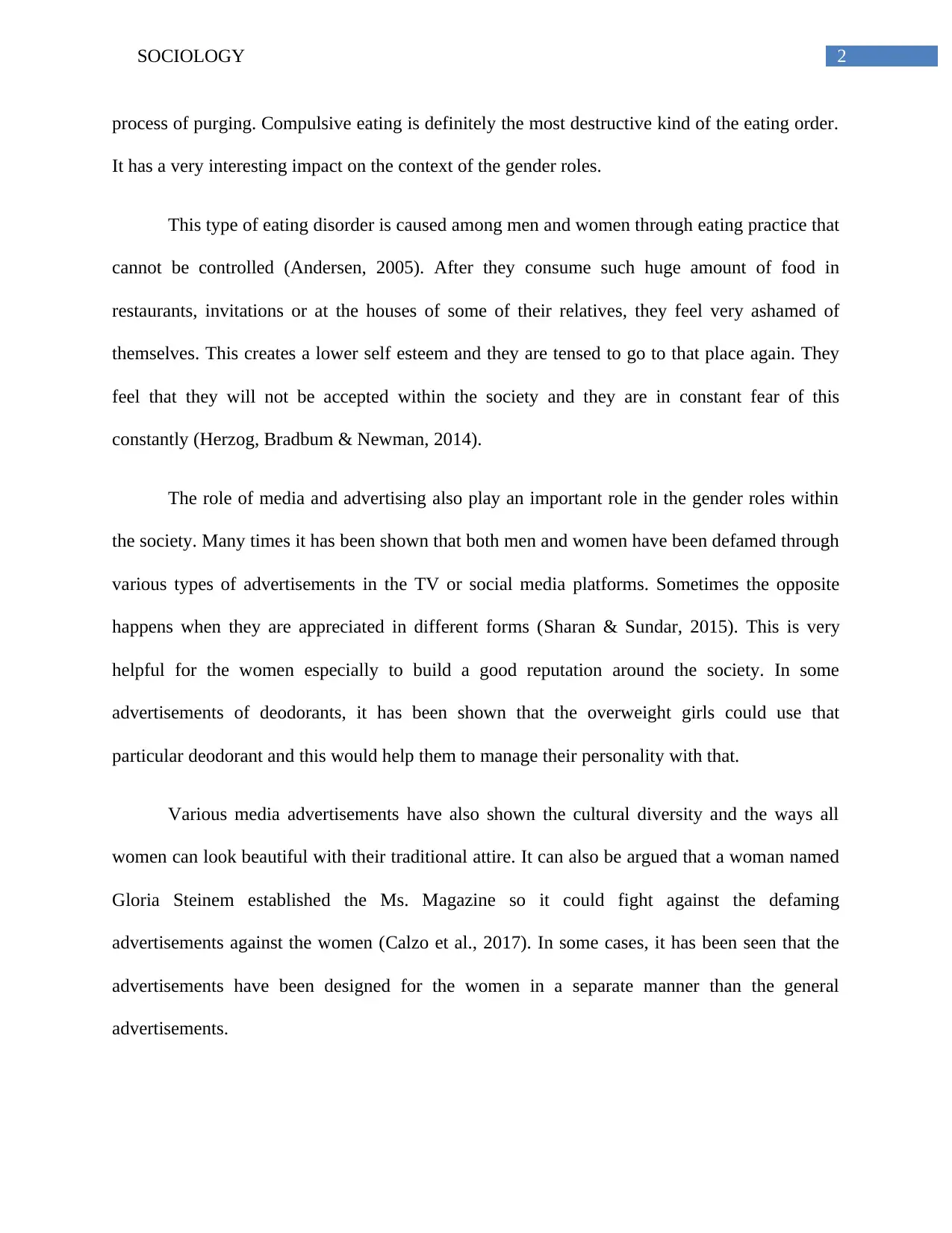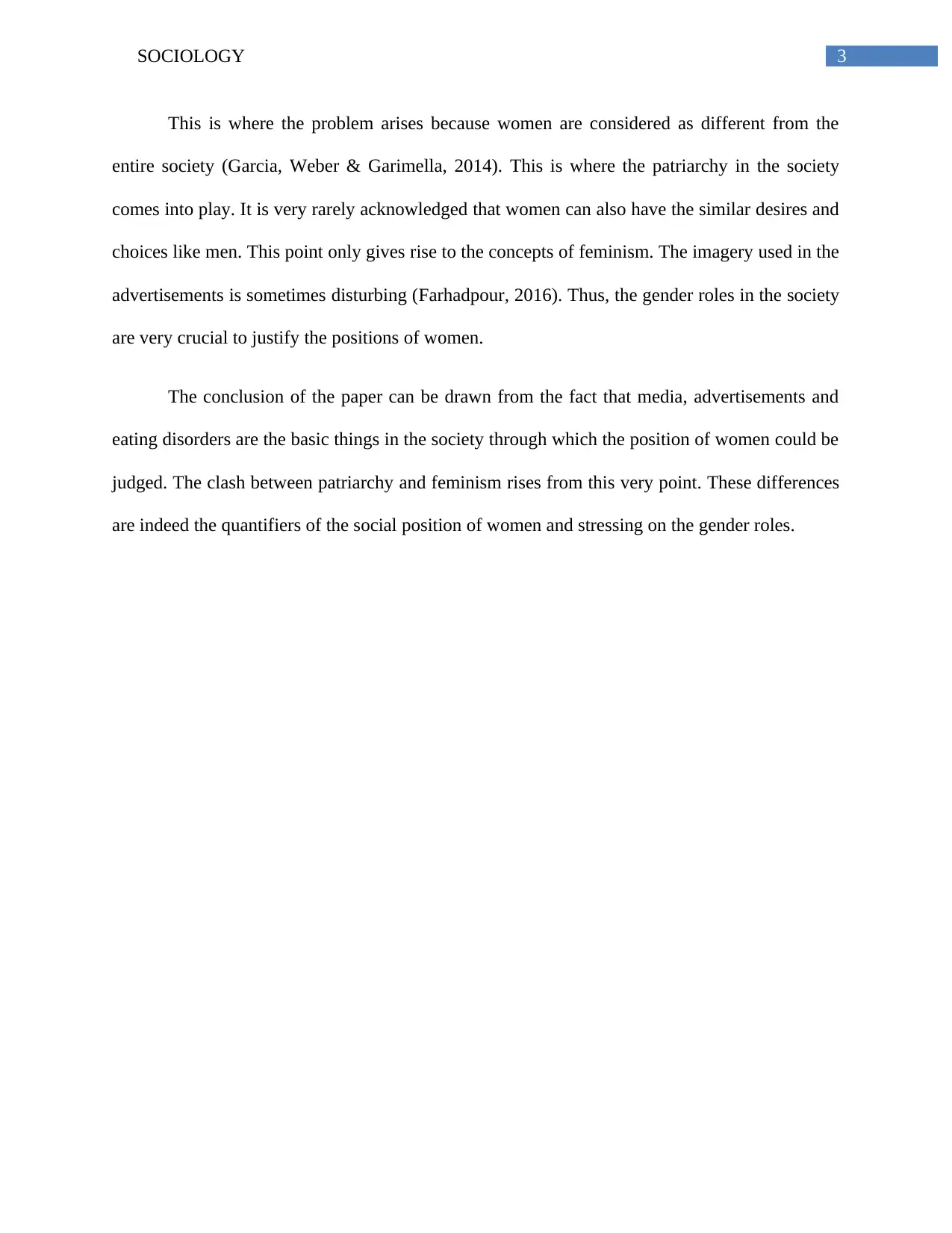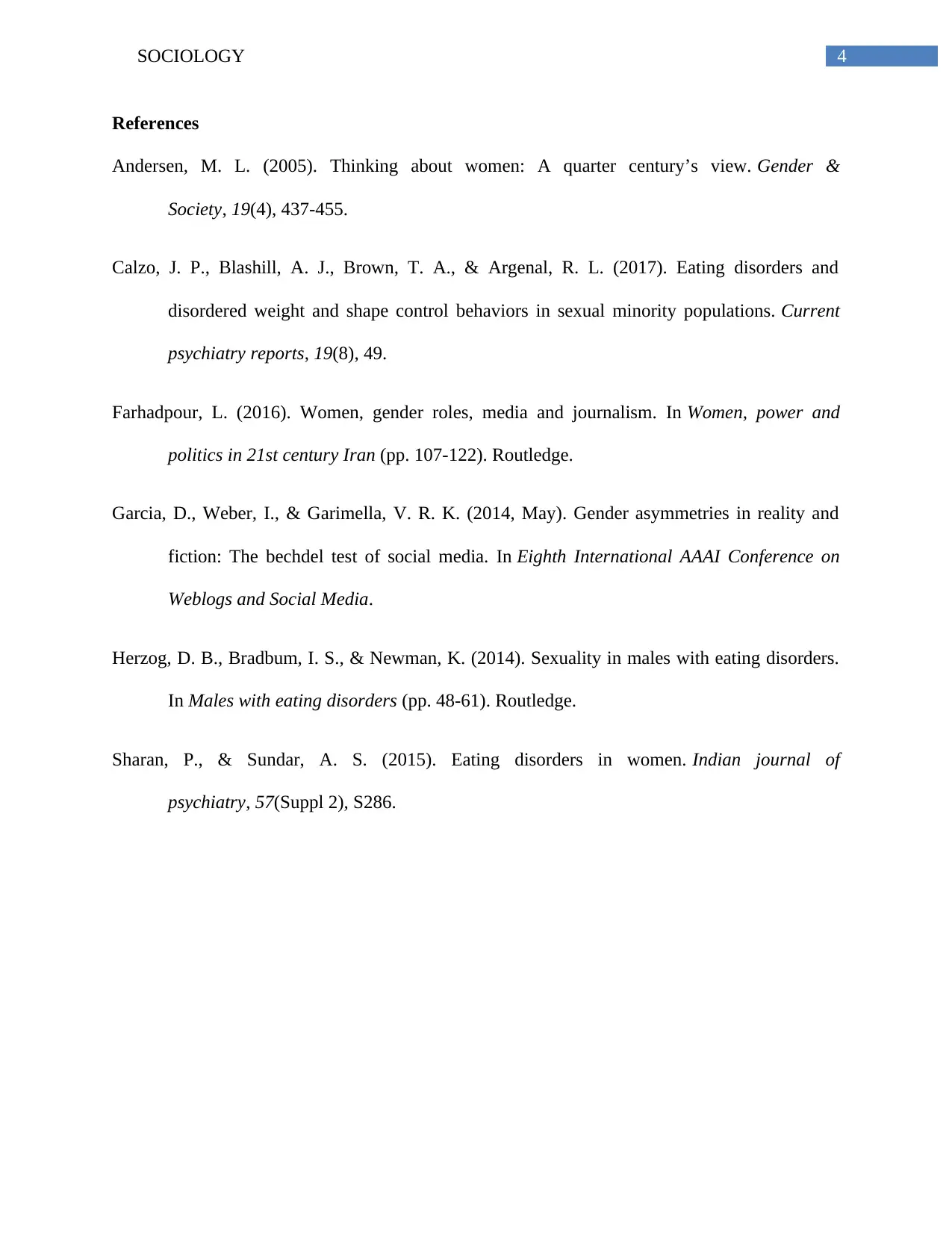Sociology: An Analysis of Gender Roles, Media, and Eating Disorders
VerifiedAdded on 2022/09/08
|5
|1108
|16
Essay
AI Summary
This sociology essay analyzes gender roles, exploring how societal expectations, media portrayals, and eating disorders such as anorexia nervosa, bulimia nervosa, and compulsive eating shape individual experiences. The paper examines the impact of media and advertising on gender perceptions, highlighting instances where both men and women are depicted in ways that reinforce or challenge traditional roles. It further discusses the influence of eating disorders, particularly among women, and how they are linked to body image issues and self-esteem. The essay also touches upon the concepts of gender identity, transgender issues, and the historical context of gender representation, including the founding of Ms. Magazine and the evolution of beauty standards. Overall, the essay argues that media, advertising, and eating disorders are crucial factors in defining the social position of women and contribute to the ongoing clash between patriarchy and feminism.

Running head: SOCIOLOGY
Sociology
Name of the Student
Name of the University
Author Note
Sociology
Name of the Student
Name of the University
Author Note
Paraphrase This Document
Need a fresh take? Get an instant paraphrase of this document with our AI Paraphraser

1SOCIOLOGY
The gender roles are very crucial to determine the place of the males and females within
the society. The discrimination in genders has been a very common incident in the society for
over decades and centuries. The concept of the gender roles in the society will be discussed in
this paper. The role socialization of the female genders and relevant biological factors will be
analyzed to gain a proper view of this matter. The examples of the socializations throughout the
life will also be identified. The role of the language and media in displaying the gender roles will
also be the topics of discussion in this section.
The eating disorders are one of the main factors behind the role socializations of the male
and females. There are three types of eating disorders that can be found. These are anorexia
nervosa, compulsive eating and bulimia nervosa. There are various types of effects and reactions
to these eating disorders (Andersen, 2005).
The anorexia nervosa means that the person is unable to maintain the body balance
compared to their age. This generally tends to distort the body image of the concerned persons.
In the context of the gender roles, it has been said that the men do not bother about this issue that
much but the women suffer from low self esteem.
They fear to go out and mix in the society in the fear that they might be insulted by their
friends (Andersen, 2005). Women are also afraid of being fat even if they are underweight. The
women in this condition will need to be very much cautious about their surroundings.
The concept of bulimia nervosa will occur in both the men and women. This creates
different types of reactions around them (Herzog, Bradbum & Newman, 2014). This is created
by the facts that both the men and women consume a great amount of food within a very short
span of time. After all these things, women try to get rid of the extra weight from the food by the
The gender roles are very crucial to determine the place of the males and females within
the society. The discrimination in genders has been a very common incident in the society for
over decades and centuries. The concept of the gender roles in the society will be discussed in
this paper. The role socialization of the female genders and relevant biological factors will be
analyzed to gain a proper view of this matter. The examples of the socializations throughout the
life will also be identified. The role of the language and media in displaying the gender roles will
also be the topics of discussion in this section.
The eating disorders are one of the main factors behind the role socializations of the male
and females. There are three types of eating disorders that can be found. These are anorexia
nervosa, compulsive eating and bulimia nervosa. There are various types of effects and reactions
to these eating disorders (Andersen, 2005).
The anorexia nervosa means that the person is unable to maintain the body balance
compared to their age. This generally tends to distort the body image of the concerned persons.
In the context of the gender roles, it has been said that the men do not bother about this issue that
much but the women suffer from low self esteem.
They fear to go out and mix in the society in the fear that they might be insulted by their
friends (Andersen, 2005). Women are also afraid of being fat even if they are underweight. The
women in this condition will need to be very much cautious about their surroundings.
The concept of bulimia nervosa will occur in both the men and women. This creates
different types of reactions around them (Herzog, Bradbum & Newman, 2014). This is created
by the facts that both the men and women consume a great amount of food within a very short
span of time. After all these things, women try to get rid of the extra weight from the food by the

2SOCIOLOGY
process of purging. Compulsive eating is definitely the most destructive kind of the eating order.
It has a very interesting impact on the context of the gender roles.
This type of eating disorder is caused among men and women through eating practice that
cannot be controlled (Andersen, 2005). After they consume such huge amount of food in
restaurants, invitations or at the houses of some of their relatives, they feel very ashamed of
themselves. This creates a lower self esteem and they are tensed to go to that place again. They
feel that they will not be accepted within the society and they are in constant fear of this
constantly (Herzog, Bradbum & Newman, 2014).
The role of media and advertising also play an important role in the gender roles within
the society. Many times it has been shown that both men and women have been defamed through
various types of advertisements in the TV or social media platforms. Sometimes the opposite
happens when they are appreciated in different forms (Sharan & Sundar, 2015). This is very
helpful for the women especially to build a good reputation around the society. In some
advertisements of deodorants, it has been shown that the overweight girls could use that
particular deodorant and this would help them to manage their personality with that.
Various media advertisements have also shown the cultural diversity and the ways all
women can look beautiful with their traditional attire. It can also be argued that a woman named
Gloria Steinem established the Ms. Magazine so it could fight against the defaming
advertisements against the women (Calzo et al., 2017). In some cases, it has been seen that the
advertisements have been designed for the women in a separate manner than the general
advertisements.
process of purging. Compulsive eating is definitely the most destructive kind of the eating order.
It has a very interesting impact on the context of the gender roles.
This type of eating disorder is caused among men and women through eating practice that
cannot be controlled (Andersen, 2005). After they consume such huge amount of food in
restaurants, invitations or at the houses of some of their relatives, they feel very ashamed of
themselves. This creates a lower self esteem and they are tensed to go to that place again. They
feel that they will not be accepted within the society and they are in constant fear of this
constantly (Herzog, Bradbum & Newman, 2014).
The role of media and advertising also play an important role in the gender roles within
the society. Many times it has been shown that both men and women have been defamed through
various types of advertisements in the TV or social media platforms. Sometimes the opposite
happens when they are appreciated in different forms (Sharan & Sundar, 2015). This is very
helpful for the women especially to build a good reputation around the society. In some
advertisements of deodorants, it has been shown that the overweight girls could use that
particular deodorant and this would help them to manage their personality with that.
Various media advertisements have also shown the cultural diversity and the ways all
women can look beautiful with their traditional attire. It can also be argued that a woman named
Gloria Steinem established the Ms. Magazine so it could fight against the defaming
advertisements against the women (Calzo et al., 2017). In some cases, it has been seen that the
advertisements have been designed for the women in a separate manner than the general
advertisements.
⊘ This is a preview!⊘
Do you want full access?
Subscribe today to unlock all pages.

Trusted by 1+ million students worldwide

3SOCIOLOGY
This is where the problem arises because women are considered as different from the
entire society (Garcia, Weber & Garimella, 2014). This is where the patriarchy in the society
comes into play. It is very rarely acknowledged that women can also have the similar desires and
choices like men. This point only gives rise to the concepts of feminism. The imagery used in the
advertisements is sometimes disturbing (Farhadpour, 2016). Thus, the gender roles in the society
are very crucial to justify the positions of women.
The conclusion of the paper can be drawn from the fact that media, advertisements and
eating disorders are the basic things in the society through which the position of women could be
judged. The clash between patriarchy and feminism rises from this very point. These differences
are indeed the quantifiers of the social position of women and stressing on the gender roles.
This is where the problem arises because women are considered as different from the
entire society (Garcia, Weber & Garimella, 2014). This is where the patriarchy in the society
comes into play. It is very rarely acknowledged that women can also have the similar desires and
choices like men. This point only gives rise to the concepts of feminism. The imagery used in the
advertisements is sometimes disturbing (Farhadpour, 2016). Thus, the gender roles in the society
are very crucial to justify the positions of women.
The conclusion of the paper can be drawn from the fact that media, advertisements and
eating disorders are the basic things in the society through which the position of women could be
judged. The clash between patriarchy and feminism rises from this very point. These differences
are indeed the quantifiers of the social position of women and stressing on the gender roles.
Paraphrase This Document
Need a fresh take? Get an instant paraphrase of this document with our AI Paraphraser

4SOCIOLOGY
References
Andersen, M. L. (2005). Thinking about women: A quarter century’s view. Gender &
Society, 19(4), 437-455.
Calzo, J. P., Blashill, A. J., Brown, T. A., & Argenal, R. L. (2017). Eating disorders and
disordered weight and shape control behaviors in sexual minority populations. Current
psychiatry reports, 19(8), 49.
Farhadpour, L. (2016). Women, gender roles, media and journalism. In Women, power and
politics in 21st century Iran (pp. 107-122). Routledge.
Garcia, D., Weber, I., & Garimella, V. R. K. (2014, May). Gender asymmetries in reality and
fiction: The bechdel test of social media. In Eighth International AAAI Conference on
Weblogs and Social Media.
Herzog, D. B., Bradbum, I. S., & Newman, K. (2014). Sexuality in males with eating disorders.
In Males with eating disorders (pp. 48-61). Routledge.
Sharan, P., & Sundar, A. S. (2015). Eating disorders in women. Indian journal of
psychiatry, 57(Suppl 2), S286.
References
Andersen, M. L. (2005). Thinking about women: A quarter century’s view. Gender &
Society, 19(4), 437-455.
Calzo, J. P., Blashill, A. J., Brown, T. A., & Argenal, R. L. (2017). Eating disorders and
disordered weight and shape control behaviors in sexual minority populations. Current
psychiatry reports, 19(8), 49.
Farhadpour, L. (2016). Women, gender roles, media and journalism. In Women, power and
politics in 21st century Iran (pp. 107-122). Routledge.
Garcia, D., Weber, I., & Garimella, V. R. K. (2014, May). Gender asymmetries in reality and
fiction: The bechdel test of social media. In Eighth International AAAI Conference on
Weblogs and Social Media.
Herzog, D. B., Bradbum, I. S., & Newman, K. (2014). Sexuality in males with eating disorders.
In Males with eating disorders (pp. 48-61). Routledge.
Sharan, P., & Sundar, A. S. (2015). Eating disorders in women. Indian journal of
psychiatry, 57(Suppl 2), S286.
1 out of 5
Your All-in-One AI-Powered Toolkit for Academic Success.
+13062052269
info@desklib.com
Available 24*7 on WhatsApp / Email
![[object Object]](/_next/static/media/star-bottom.7253800d.svg)
Unlock your academic potential
Copyright © 2020–2025 A2Z Services. All Rights Reserved. Developed and managed by ZUCOL.


